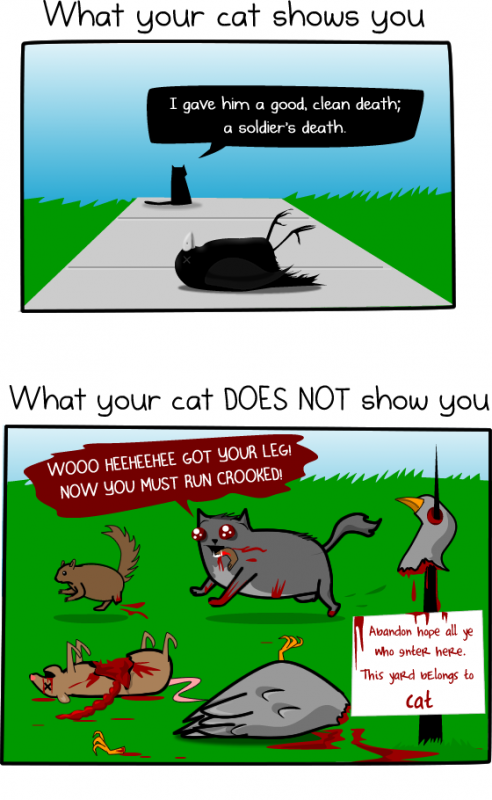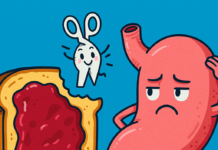Let’s get one…thing…straight. Cats are obligate carnivores. For those of you who don’t know what that means, it means this: “An obligate carnivore is an animal that must eat the tissue of other animals in order to thrive, according to its genetic makeup.” It also means that vegans who decide to feed their cats vegetarian food, are literally taking part in animal abuse. So freaking STOP it.
Sure cats are cute, but they’re also evil, maniacal, cunning, manipulative meat eaters. Everything about how a cat is built is made to make them extremely efficient killing machines. If you think I’m exaggerating, just check out this informative, yet frightening cartoon: How Much do Cats Actually Kill – The Oatmeal.

Why am I trying to drive home the point that they’re blood-thirsty, evil machines of DEATH? Because I need you to understand that you’ve probably been feeding your cat the wrong food for its entire life. Most cat food has tons of fillers and useless, often harmful, ingredients. Ingredients such as wheat gluten, corn, rice, and fruit are not only useless to a carnivore, but their bodies are not built to process them. The only time a cat eats a grain, fruit, or vegetable is when they eat the predigested stomach contents of their prey (doesn’t that just make you want to pet Snowball now?).
The other lesson I feel the urge to teach is that we already have issues with the FDA regulating human food, so imagine what little effort they put into regulating pet food. The FDA claims that they sorta kinda do, but if you read carefully they say “There is no requirement that pet food products have pre-market approval by the FDA.” This can be pretty shocking to people who love their pets like they love their own children. Would you feel confident feeding your child food from China (no offense China, but you have a bad rap where imported food is concerned) that isn’t required to be approved by the FDA? The most well known case of this being an issue was in 2007, when an estimated 3,600 pets died from contaminated wheat gluten imported from China.
It was after this very recall that I had a “no s#&*!” moment, and realized that what I fed my cat was the most important factor in keeping her healthy. I discovered that I’d been doing it all wrong by feeding her Fancy Feast.
What do Cats Eat?
Bloody, Glorious, Meat
As mentioned before, cats are classified as obligate carnivores. When the term “obligate” is added to the word carnivore, it means “carnivore by necessity.” This means that cats literally need the majority of their diet to be meat in order to survive. Their bodies have evolved over time to be efficient at breaking down and processing meat, and to be really horrible at processing foods like grains, fruits, and vegetables.
Feeding a cat corn would be like me eating cardboard; my body would say, “what the what is this???”, attempt to process the cardboard to the best of its ability, and absorb zero nutrients in the process. If I was continuously eating cardboard, my body would eventually shut down from all the cardboard consumption. So, if you’re a militant vegan or vegetarian, you basically shouldn’t own a cat. And if you do and feed your cat vegetarian cat food, you are slowly killing your cat. Congrats.
They Hate Our Healthy Food
I fell into the trap of thinking that my cat needed to eat all the healthy things I was eating, such as brown rice, fruits, and veggies. Then I noticed that every time I fed her Fancy Feast that included brown rice, she’d throw up without fail. This is because her body is not built to process freaking rice. Ever see a cat wandering around a rice field looking for food?
Think of it this way, cats that live out in the wild do not climb trees to eat fruit, nibble on wheat stalks, or dig up potatoes from the ground. They hunt, kill, and feast on living beings (those murderous little bastards). The small amount of veggies, fruits, and grains they get in their diet comes from eating the contents of their prey’s stomach (as previously mentioned). Small amounts of cooked/digested foods such as these are OK, but shouldn’t make up anymore than 3-4% of a cats diet.
Waterzzzz

As much as cats hate being in water, they need tons of moisture in their food. They get 70% of their “water” from their prey. But when you feed your cat nothing but hard pellets, you’re depriving them of moisture, which can lead to kidney and bladder problems. To compare, wet food gives your cat about 78% moisture while hard food gives them 10%. That’s why veterinarians recommend that your cat drinks a cup of water per day if you’re feeding them dry food.
I don’t know about your cat, but mine doesn’t really give a flying squirrel about water. So it’s easier for me to feed her wet food in order to ensure she’s getting the moisture she needs. I actually add extra water to her wet food and mash it up!
And contrary to the popular held belief, it has been proven that dry food does not improve dental health in cats. Considering that the majority of domestic cats eat dry food and the most common health issue in cats is dental disease, it’s obviously not working.
What should we do?
I feed my cat wet food in the morning and again at night. In between those times, I leave out some dry food in case she gets hungry. But the majority of her diet comes from meat-based, wet food. PROTIP: If you store wet food in the fridge, heat it up in the microwave before feeding your kitty. Cats like their prey warm, not cold!
She has less hairballs, hardly ever gets sick (knock on wood), her poops are healthy (ya’ll know how much I love checking poop), and basically looks like a model. Doesn’t she?

Read and Understand Ingredient Labels
The main ingredients you want to avoid are the following:
- Wheat Gluten or any type of wheat
- Corn (basically anything corn such as high fructose corn syrup, canola oil, etc.)
- Soy
- Rice
- Fruits and vegetables (Only ok if they’re listed very low on the ingredient label. That means that they don’t make up the majority of the ingredients.)
- Preservatives such as BHA, BHT, and ethoxyquin
- Carageenan
- Natural flavors
Ingredients you want in your cat food:

- Meat! Meat! Meat! You want to see that the first few ingredients are things like chicken, beef, fish, etc. And try to stay away from meat ingredients that say “bi-product” or “meat, poultry, fish meals.” This means that the meat has gone through an extensive process of being boiled down and leads to a removal of nutrients.
- Taurine
- Arginine
- Vitamins
- Moisture
To learn more about AAFCOs (Association of American Feed Control Officials) guidelines for Guaranteed Analysis of kitten/cat cat food, click here. And here’s a handy-dandy page explaining nutritional labels on pet food.
Recommended Brands
Most likely you will never find the “perfect” cat food. Some people give up and end up making raw food and feeding that to their cats. I however, am lazy and scared that I’ll accidentally poison my kitty, so instead give her the best store brands that I can find. Some examples of healthier alternatives are:
- Primal Pet Foods: Dehydrated meat for those who want to feed their kitty raw, but are too scared to go “all the way.” Freeze-dried raw food that just needs water added to make it a meal.
- Weruva: People Food for Pets – Uses potato starch as a thickener, but the owner verified that it’s about 1% of the ingredients. Their “Cats in the Kitchen” products are my kitty’s fave!
- B.F.F.: Best Feline Friends – Uses tapioca starch as a thickener, but the owner verified that it’s about 1% of the ingredients
- Orijen: For those who want a healthy dry food option
- Stella & Chewy’s: For those of you who want to experiment with raw but are nervous about it. Freeze-dried raw food that just needs water added to make it a meal.
- Tiki Cat: Probably the cheapest option. Read the labels though because some of the flavors have Carageenan added.
So those are just a few that I’ve found to be good, but I’m sure there’s more. Do a little investigation on your own! It’s worth it to keep your fuzzy, murderous friend healthy and happy!
References
http://www.catster.com/cat-food/cat-food-wet-or-dry
http://feline-nutrition.org/nutrition/reading-a-pet-food-ingredient-label
http://feline-nutrition.org/answers/answers-what-exactly-is-an-qobligate-carnivoreq













